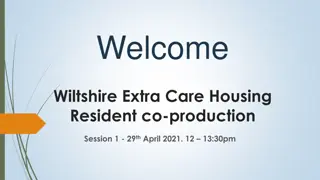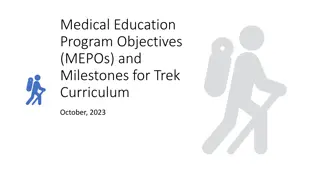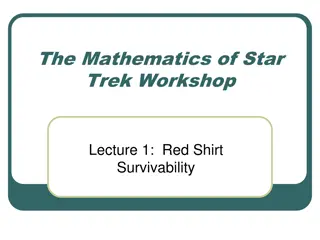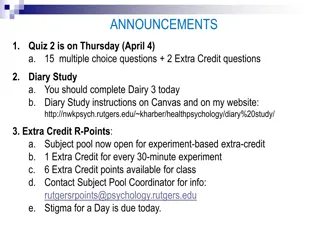
Academic Success Factors for American Indian Students at TrekNorth
Explore the factors impacting academic success among American Indian students at TrekNorth Jr. & Senior High School in Bemidji, MN, shedding light on strategies, challenges, and key considerations for achieving positive educational outcomes.
Download Presentation

Please find below an Image/Link to download the presentation.
The content on the website is provided AS IS for your information and personal use only. It may not be sold, licensed, or shared on other websites without obtaining consent from the author. If you encounter any issues during the download, it is possible that the publisher has removed the file from their server.
You are allowed to download the files provided on this website for personal or commercial use, subject to the condition that they are used lawfully. All files are the property of their respective owners.
The content on the website is provided AS IS for your information and personal use only. It may not be sold, licensed, or shared on other websites without obtaining consent from the author.
E N D
Presentation Transcript
Academic Success Factors and Strategies for American Indian and Other Student Demographic Populations Trek North Jr. & Senior High School Bemidji, MN January 28, 2015
Focus Features of TrekNorth Successful Charter School High Minority and Free/Reduced Lunch Count Hi Caliber Curriculum State and National Recognition Waiting List Resilient, Compassionate, Honest, Responsible, Motivated
American Indian Students at TrekNorth In general, American Indian students are enrolled in lower-standard academic programs within District 31, while at TrekNorth they are enrolled in AP/Pre-AP level programming. Data related to enrollment in area schools demonstrates the fact that TrekNorth is doing more to deliberately address the achievement gap than other schools. (2014 Annual Report)
And the Literature Says: Factors that May Impact American Indian Student Success Are: Access and Enrollment in Early Childhood Programs Free/Reduced Lunch Status (Poverty) High Minority Population in High Poverty School ESL Status Absences Percentage of Students Retained in a Grade Percentage of Students Suspended or Expelled (Harwood, 2011)
And the Literature Says: Factors that May Impact American Indian Student Success Are: Quality of Teachers/Teacher Training Class Size Rigorous Curriculum Before/After School Support and Summer Programs Cultural Dissonance between Native American Culture and the Traditional School Setting Cultural dissonance as a Result of Historical Implications (Harwood, 2011)
Factors that Do/Dont Impact American Indian Academic Success Self-Esteem Impacted by Personal Resources (perceived competence, internal locus of control, problem- focused coping) Impacted by Problem Behaviors (antisocial behavior, problems with alcohol, drug use). American Indian Identity No relationship (Whitesell, Mitchell, Spicer)
Poverty, American Indian Status, and Academic Achievement American educational research and research across the world have identified socioeconomic status (SES) to be recurrently linked to students academic achievement (Perry, Link, Boelter, Leukefeld, 2012; Tomul & Savasci, 2012; Vale, Weaven, Davies, Hooley, Davidson, & Loton, 2013).
Basics of Comprehensive Study of Education and Related Services on the White Earth Indian Reservation: Part II 2,800 students 140 parents 400 teachers 7 schools Grades 3-12 Mixed-Methods Early childhood, social services, health services
Predictor Variables Appraisal Data (AAII) Self(e.g., I feel that I do my best in school ) Parents and Home Environment (e.g., I feel safe at home Own Behavior (e.g., I get in trouble in school ) Teacher(e.g., My teacher makes sure that I know how to do something before moving onto something else ) Relationships(e.g., My classmates influence my behavior and performance in school more than any other thing ) School Environment (e.g., I feel safe at school ) Demographic data Lunch code Absenteeism Tardiness Discipline among others
6 Constructs Self-Perception (favorite subject, good at, succeed in school) Teachers (explains things, tests what is taught, helps me) Parents/Home Life/Community (caregiver cares if student goes to school, caregiver would rather watch TV than help me, books in the home) Student Behaviors (do homework every night, read or watch TV, drug and alcohol use) School Environment (school lunch, tired in school, safe on bus) Relationships (I like teachers, teachers like me, bullied)
NSLP Demographic Information White American Indian Free Reduced Full Payment Free Reduced Full Payment Price Price Grades 310 62 133 181 12 40 3-5 Grades 302 154 837 243 45 140 6-12 Total 612 216 1070 424 57 180
General Observations from the White Earth Study Data showed that White students outperformed American Indian students on both math and reading MCA tests and reported higher levels of perception of the teacher, parents, own behavior and relationships. Data also indicated that American Indian students were involved in more disciplinary problems and had higher absences and tardiness rates than their White peers. Groups were equal in their performance on both math and reading MAP tests and the perception of self and perception of the school environment.
SES Findings (White Earth Study) Overall, SES (as determined by lunch program) determines differences in the students' appraisal of variables we assumed could impact their academic performance. American Indian students performed similarly on MCAs and MAP, whether FREE, PAID, or REDUCED, and there was virtually zero impact on any of the selected variables among American Indian students. The results tell a different story for White students.
White American Indian One-Way ANOVA Effect MCA Math F(2,542) = 14.64, p = .000 No Effect (NE) Lunch Program and Academic Achievement MCA Reading Effect NE F(2,678) = 8.66, p = .000 MAP Math No Effect (NE) NE Grades 6-12 MAP Reading NE NE
White American Indian One-Way ANOVA Discipline No Effect (NE) No Effect (NE) Absenteeism Effect NE Lunch Program and Behavioral Demographics and Appraisal of Influences F(2,466) = 6.79, p = .001 Effect Tardy Days NE F(2,445) = 9.25, p = .000 NE Perception of Self NE Perception of Own Behavior Effect NE Grades 6-12 F(2,325) = 4.40, p = .013 Perception of Parents and Home Environment Effect NE F(2,360) = 3.25, p = .040 NE Perception of School NE Perception of Teachers NE NE Perception NE NE of School Relationships
SES Impact of White Students On MCAs, FREE lunch program White students obtained the lowest scores across grades. White students in the FREE lunch program obtained the highest rates of absenteeism and tardiness and reported the lowest levels of appraisal of own behavior, parent and home life, and relationships.
SES Impact on White Students (continued) Free lunch students were tardy and absent far more than reduced-pay students, who were tardy more than full-pay students. Free lunch students had lower self-perception than reduced-pay students, who had lower self- perception than full-pay students. Perception of parents and home life is highest for full-pay students, followed by reduced, followed by free lunch students (significantly lower).
Team Time The question that follows from these results is what could possibly explain these differentiated results across ethnicities? We know that White students with the lowest SES are absent more, tardy more, have a lower self-perception, lower perception of home life, lower self-perception, lower perception of own behavior, and lower perception of relationships. Possible Interventions?
Impact of Variables MCA Math (6-12) 12) MCA Reading MAP Math (6- MAP Reading (.85**) (.73**) MAP Math MCA Math NA NA Percept. of Behavior MCA Reading (.26**) (.37**) Percept Parents (.36**)
Impact of Variables MCA Reading (6-12) MAP Reading (6-12) MCA Math MAP Math (.78**) Percept. of Behavior MAP Math (.85**) (.40*) (.26**) MAP Reading Percept. of School MCA Reading MAP Reading MCA Reading Percept. of Parents (.32**) (.34**) NA (.34**) .23** NA Percep. of Parents GPA (.46**) (.25**) Percept. of Behavior Absence Discipline (.47**) (-.23*) (-.28**)
Impact of Variables Cumulative GPA (6-12) MCA Reading (.46**) Percept. of Relats. (.19*) Discipline (-.40**) Cum. Percept. of School (.20**) Absence GPA (-.52*) NA Percept. of Teacher Tardiness -.42** (.20*) Percept. of Self (.27**)
Impact of Variables MCA Reading (6-12) MCA Math (6-12) MCA Reading score (an increase increases MCA Math score) MCA Math score (an increase increases MCA Reading score) Model fit R2 = .53 (53%) Model fit R2 = .34 (34%) The MCA Reading score can predict 53% of the changes on students MCA Math scores. The MCA Math score can predict 34% of the changes on students MCA Reading scores.
Impact of Variables (continued) MAP Math (6-12) MAP Reading (6-12) MAP Reading score (an increase increases MAP Math score) MAP Math score (an increase increases MAP Reading score) Model fit R2 = .72 (72%) Model fit R2 = .72 (72%) The MAP Reading score can predict 72% of the changes on students MAP Math scores. The MAP Math score can predict 72% of the changes on students MAP Reading scores.
TrekNorth Reading Goals 2013-14 Proficiency Goals Reading The percentage of all students enrolled October 1 in grades 6-11 at TrekNorth High School who earn an achievement level of Meets the Standards or Exceeds the Standards on all reading state accountability tests (MCA, MOD, MTAS) will increase from 60.2% in 2013 to 63.2% in 2014. (Increase of 3 percentage points) 2014 TrekNorth Reading Proficiency for Grades 6, 7, 8, 10 = 62% (82/133) (2014 Annual Report)
Team Time Reading skills limit American Indian students ability to succeed on the MCA math tests. Do you feel that you have observed deficient reading skills as detrimental to success in math? If so, provide an example. What strategies are you employing to improve reading skills? Why do you think students (American Indian, in particular) change their perception of math as they advance through grades?
All Students Cumulative GPA (6-12) Number of absences (an increase reduces GPA) Number of tardy days (an increase reduces GPA) Perception of student s own behavior (an increase increases GPA) Model fit R2 = .48 (48%) These three variables have the power to predict 48% of the change on students cumulative GPA.
Questions within Behavior Construct I spend most of my afternoon and night after school watching TV or playing video games. I do my homework every night that I have homework. Homework really helps me to learn . I would learn more if teachers spent more time in class working with me on things and skills rather than assigning me homework. I would rather read than watch TV. I play sports, play instruments, or do things with kids after school and on weekends. I go to church and/or participate in church activities. I use tobacco, drugs, or alcohol.
Behavior Construct Questions (continued) I get in trouble in school. My alcohol/drug use has a negative impact on my performance at school (answer only if you use alcohol/drugs). My alcohol/drug use causes me to skip school (answer only if you use alcohol/drugs). I am involved in extracurricular (after school) activities. I do better in school because I m involved in extracurricular (after school) activities. I exercise (do physical activity) every day or almost every day.
Behavior Construct Questions (continued) I don t participate in extracurricular (after school) activities because I don t have transportation to get to and from practice and games. I don t participate in extracurricular activities because I don t have the money to pay the activity fee. My coaches care about me as a person. My coaches care about me only if I can help them win contests. Social networking (e.g. Face book) is a positive influence on my behavior and performance in school. I stay up late on school nights chatting with my friends on the cell phone, Face book, or in some other electronic way.
Team Time Think about the predictive value of reading test scores on math test scores and vice-versa. Possible courses of action to increase test scores? Since a student s perception of his/her own behavior, combined with attendance (or lack of) and punctuality/tardiness account for nearly of the influence on GPA, can you think of any interventions that you could do or be part of at TrekNorth in relation to the student behavior construct questions in the previous slides?
Questions within Self-Perception Construct (Grades 6-12) I like school. My family has enough money to meet my needs. I feel that I do my best in school. I m happy most of the time. I get picked on in school. My favorite subject in school is:
Questions within Self-Perception Construct (Continued) My least favorite subject in school is: My hardest subject in school is: I am good at: I think success in school is: If I succeed in school, it is usually due to: If I don t succeed in school, it is usually due to:
Team Time What was the favorite subject? What was the least favorite subject? What do you think was selected as the hardest subject? What defines success in school? Kids attributed success to who/what? So what?
Answers to Previous Slide Favorite Subject Subject White Students (Grades 6-12) American Indian Students (Grades 6-12) Math 23.6 % 16% Reading 10.3% 11.7% Science 19.7% 15.6% Social Studies 14.6% 13.5% Another Subject 24.8% 36.5%
Answers to Previous Slide Least Favorite Subject Subject White Students (Grades 6-12) American Indian Students (Grades 6-12) Math 32.7% 40.1% Reading 21.1% 18.1% Science 14.6% 12.1% Social Studies 10.7% 11.7% Another Subject 10.8% 9.6%
Answers to Previous Slide Hardest Subject Subject White Students (Grades 6-12) American Indian Students (Grades 6-12) Math 38.8% 45.4% Reading 11.8% 9.6% Science 16% 16.6% Social Studies 15.4% 15.6% Another Subject 6.9% 6.7%
Answers to Previous Slide Both White children and American Indian children define success in school as good grades. White = 70.3 American Indian = 71.3
Answers to Previous Slide Children attributed success to: Factor White Students (Grades 6-12) American Indian Students (Grades 6-12) Attendance 3.8% 6% Coaches 1.4% 1.1% Friends 4.5% 7.1% Myself 51.5% 43.3% Other Reasons 5.8% 7.8% Parents/Caregivers 11.5% 13.5% Teachers 16.7% 17.7%
Recommendations: Qualitative (Self-perception Construct: General) Reading: Pre-assessment is critical at all levels. Leveling Differentiation Math is found to be difficult by many students, and it is the least-liked subject overall. Alternative approaches to teaching math Authentic education and assessment Allow re-takes of summative assessments (applicable to all subjects) AI parents do not view attendance as critical to academic success as do White parents. Work with AI parents to get their children to school on time.
Team Time What are your thoughts on previous slide? Pre-assessment (leveling/differentiation) Alternative approaches to teaching math Authentic assessment Re-takes Attendance efforts/Communication with home
Team Time Discuss your teaching methodology with your colleagues. What does it look like? How do you know that the kids get it?
Teacher Factors Question White Students American Indian Students The teacher has lots of things for students to do every day 7.2% 10.3% The teacher cares about me 5.1% 1.1% The teacher makes sure kids behave well 2.4% 2.8% The teacher is smart 3.3% 2.1% The teacher can explain things 48.9% 39.4% The teacher helps me in class 8.4% 12.1% The teacher assigns homework about the things that I learned in class 9.1% 11.7% The teacher believes that I can learn 6.3% 7.8%
Team Time Discuss how you plan your lessons. What drives your lesson? In particular, think about activities, assessments, and outcomes. Do you ever assess students before they get it?
Backward by Design Determine Outcomes Outcomes Formative Assessments Summative Assessments Assessments Teacher-Centered Student-Centered Activities
Team Time If students are not succeeding in your class on summative assessments, do you take time to really look at what the student got wrong and compare the assessment to the essential learning outcome? Do you think about how you taught the material and whether there would be alternative ways of presenting and explaining it? Do you look at median scores?
Recommendations: Qualitative (Teacher Construct: General) Teacher capacity to explain things was identified as critical. Uniform methodological approach across all grades and subjects. Madeline Hunter s direct instruction is recommended. Standards (outcomes) Anticipatory Set (Hook) Teaching (input, modeling, checking for understanding) Guided Practice/Monitoring Closure Independent Practice
Recommendations: Qualitative (Teacher Construct: General) There must be a cultural shift in thinking among teachers. Teachers do not see themselves as a critical factor in student underachievement. School administrators must stand accountable for teacher implementation of recommendations. Evaluations Professional Development
Recommendations: Qualitative (Parents/Home Life Construct: General) All children should have access to breakfast, regardless of free/reduced lunch status. Get books into the homes of American Indian children. Increase teacher/parent communication, especially with American Indian population.
Recommendations: Qualitative (Student Behavior Construct: General) Homework should be assigned sparingly Up to 1/3 of students do not complete homework when it is assigned. A majority of teachers would disagree that most parents help their children with homework or check for completion. Extracurricular fees should be reduced or eliminated. Up to 1 in 5 children do not participate due to cost and transportation.






















